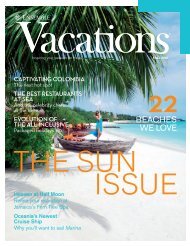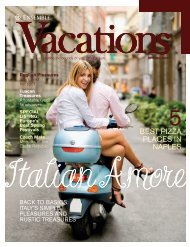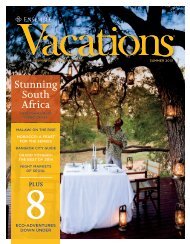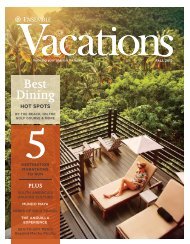Picture - Ensemble Vacations Magazine
Picture - Ensemble Vacations Magazine
Picture - Ensemble Vacations Magazine
- No tags were found...
You also want an ePaper? Increase the reach of your titles
YUMPU automatically turns print PDFs into web optimized ePapers that Google loves.
PANAMA BY<br />
THE NUMBERS<br />
Government: constitutional democracy<br />
Capital: Panama City<br />
Official language: Spanish<br />
Other languages: English, Kuna<br />
and 14 others<br />
Monetary unit: 1 balboa = $1 U.S.<br />
(U.S. dollar is also used)<br />
Electricity: 120 volts 60 Hz<br />
ATM: countrywide (but not many<br />
in lesser-populated areas)<br />
Tax: 10% added to all hotel bills;<br />
5% added to all non-food items<br />
Time zone: GMT minus 5 hours<br />
International dialing code: +507<br />
So why don’t more people know about this country? Likely because the political<br />
overtones of the past half-century have overshadowed any thoughts of tourism. A<br />
military government first took control in 1968 and although it was repressive, people<br />
still continued with their everyday lives. It wasn’t until General Manuel Noriega took<br />
power in 1981 that Panama made headlines around the world for its repression and<br />
human rights violations. Also, as we now know, the general used the country as his<br />
own personal bank and invited many notorious drug lords to do business there.<br />
However, U.S. President George H.W. Bush ordered U.S. troops into the country<br />
in 1989 (in part) “to assist the Panamanian people in restoring democracy.” For<br />
many years after – though governments have been democratically elected for the past<br />
20 years – the legacy of Noriega, currently being held in a Florida prison, still hung<br />
over the country.<br />
But all that is rapidly changing. Today Panama is ready to welcome tourists on a<br />
global scale. Cruise ships dock at Panamanian ports; ‘birders’ flock to experience an<br />
unprecedented 900 species in the parks and forests; scuba and snorkelling enthusiasts<br />
are discovering some of the finest Caribbean coral and reef fish on the Atlantic side<br />
while whale watchers gather on the Pacific side. Oh, and there are also 1,518 islands<br />
for you to discover.<br />
The outdoorsman/woman will find a naturalist’s paradise in Panama, with a full<br />
range of activities including hiking, horseback riding, fishing (try the Gulf of Chiriqui),<br />
boating, white water rafting (the country has 488 rivers), rock climbing and, after all<br />
this exertion, relaxing in the thermal hot springs in Volcán Barú.<br />
As for more urban activities, Panama City especially – but also smaller centres such<br />
as Colón, David and Gamboa – boasts all the big city pleasures you could desire. Bars<br />
and restaurants, theatres and cinemas, live bands and concert halls, art galleries and<br />
shopping, local markets and craft stores. Try the Calle Uruguay district for nightlife<br />
in Panama City.<br />
Dining is also exceptional – try a feast of beef, chicken, fish with rice and beans,<br />
colourful salads of beet, carrot or cabbage, potatoes and pasta and, of course, fresh<br />
fruits like mango, papaya and passion fruit. Yet the price may only be about $10<br />
a person. Stick to the local wine and do try the national beers, Balboa and Atlas.<br />
Finally, as you relax and digest your meal, order some world-famous Panama coffee<br />
while you enjoy the mild evening temperatures, watching the brilliant sunset over one<br />
ocean or another. In Panama, the choice is yours.<br />
Maybe it’s time to broaden your travel horizons and discover something new.<br />
New – yet so near. nV<br />
ENSEMBLE VACATIONS FALL 2009<br />
43












